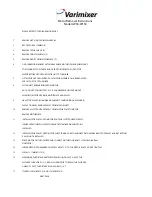
Chapter 4. Basic operation for input channels
55
Using the noise gate
As with the compressor, most parameters of the built-in noise gate of the PM1D system can be controlled manually by
using the NOISE GATE section of the SELECTED INPUT CHANNEL block.
Hint
The noise gate of the PM1D system allows you to select one of two types: GATE or DUCKING. However, the type
cannot be selected by operations in the front panel. For this reason, you must first load noise gate data that uses the
desired type from the library, and then use the SELECTED INPUT CHANNEL block to edit the parameters as neces-
sary.
The NOISE GATE section contains the following controls and functions.
NOISE GATE
NOISE GATE KEY IN FILTER [HPF]/[LPF] switch
NOISE GATE KEY IN FILTER [ON] switch
and LED
This controls the filter (HPF or LPF) that is pro-
vided for the key-in signal of the noise gate.
Use the [HPF]/[LPF] switches located at the
upper left to select the type of filter that you
wish to control. Then use the [ON] switch
located at the lower left to turn it on/off, and use
the [KEY IN FILTER] encoder at the upper right
to adjust the cutoff frequency. The HPF and
LPF can be used simultaneously.
The HPF and LPF apply only to the key-
in signal that is sent to the noise gate.
They do not affect the signal that is sent
to the STEREO bus or the MIX bus.
Hint
NOISE GATE KEY IN [CUE] switch and LED
This monitors the key-in signal after it has
passed through the filter.
NOISE GATE ATTACK/DECAY [TIME]
encoder and [VALUE] indicator
This sets the attack time/release time of the
noise gate. Use the switch located at the right to
select either ATTACK or RELEASE, and use the
[TIME] encoder to adjust the value. The current
value is shown by the [VALUE] indicator.
NOISE GATE [LINK] switch and LED
For pairable input channels, this speci-
fies whether noise gate operation will be
linked by the key-in signal (link=on) or
whether the noise gates will operate with
independent key-in signals (link=off).
(The LED will light if link is on.) For
details refer to “CS1D Reference Manual
(Hardware)”.
NOISE GATE [POST] meter LEDs
These LEDs indicate the level of the signal
after it has passed through the noise gate.
NOISE GATE [RANGE] encoder and LEDs
This sets the RANGE parameter of the internal noise gate.
The approximate current value is shown by the perimeter
LEDs.
NOISE GATE [FREQUENCY] encoder
and [VALUE] indicator
NOISE GATE SIG [+]/[THR]/[–] LEDs
These indicate the level of the noise gate key-
in signal (after passing through the filters). For
details on the meaning of each LED, refer to
“CS1D Reference Manual (Hardware)”.
NOISE GATE HOLD [TIME] encoder
and LEDs
This sets the HOLD TIME parameter of
the internal noise gate. The current value
is shown by the [VALUE] indicator.
NOISE GATE [THR] encoder and LEDs
This sets the THRESHOLD LEVEL parameter
of the internal noise gate. The approximate
current value is shown by the perimeter LEDs.
NOISE GATE [ON] switch and LED
This switches the internal noise gate on/off.
NOISE GATE [ATTACK]/[DECAY]
switches and LEDs
NOISE GATE [GR] meter LEDs
These LEDs indicate the amount of gain
reduction produced by the internal noise
gate.
Содержание CS1D
Страница 1: ...Owner s Manual ...
Страница 5: ...Operating Manual ...
Страница 6: ...Operating Manual Start up ...
Страница 55: ...Operating Manual Basic Operation ...
Страница 214: ...Reference Manual ...
Страница 215: ...Reference Manual Hardware ...
Страница 332: ...Reference Manual Software ...
Страница 530: ...Reference Manual Appendices ...
















































